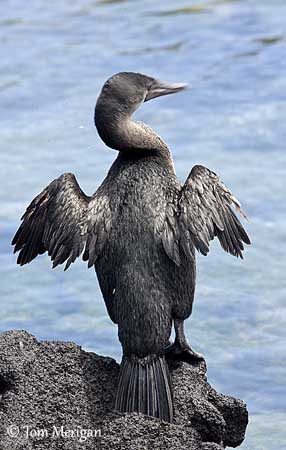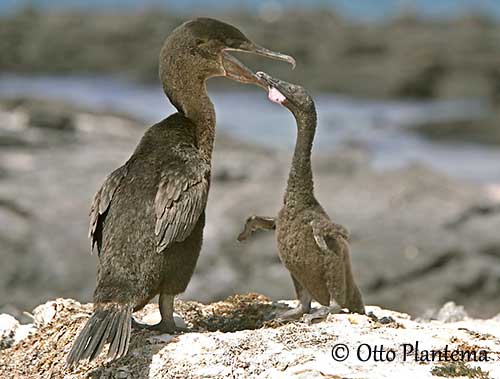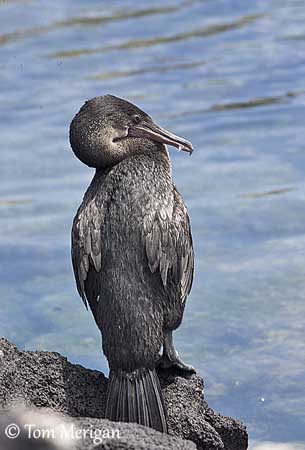
Fr: Cormoran aptère
All : Galapagosscharbe
Esp : Cormorán Mancón
Ital : Cormorano delle Galapagos
Nd: Galápagosaalscholver
Sd: Galapagosskarv
Photographer:
Tom Merigan
Tom Merigan’s Photo Galleries
Otto Plantema
Trips around the world
Text by Nicole Bouglouan
Sources:
HANDBOOK OF THE BIRDS OF THE WORLD vol 1 by Josep del Hoyo-Andrew Elliot-Jordi Sargatal - Lynx Edicions - ISBN: 8487334105
L’ENCYCLOPEDIE MONDIALE DES OISEAUX - Dr Christopher M. Perrins - BORDAS - ISBN: 2040185607
BirdLife International (BirdLife International)
Wikipedia, the free encyclopaedia
Flightless Cormorant
Phalacrocorax harrisi
Suliformes Order – Phalacrocoracidae Family
BIOMETRICS:
Length: 89-100 cm
Weight: 2500-4000 g
Wing length: about 25 cm
DESCRIPTION:
The Flightless Cormorant is native to the Galapagos Islands. This is the only member of this family unable to fly.
This species is rare, with small populations and restricted range.
Male is heavier than female but they have similar plumage.
The adult has dark plumage overall, mostly greyish-black. Upperwing and scapulars appear paler grey with black-edged feathers, giving the typical scaled pattern of several cormorants. Wings and tail are glossy, and may appear almost white according to the light.
The underparts are brownish.
The bill is blackish with yellowish lower mandible. The eyes are turquoise. The short, strong legs and the large webbed feet are black.

The juvenile is blacker, with brown eyes.
VOICE: SOUNDS BY XENO-CANTO
The Flightless Cormorant produces low growling sounds. It is usually silent outside the breeding season, and vocal displays are often related to breeding and roosting behaviour.
HABITAT:
The Flightless Cormorant frequents the rocky shores of the volcanic islands where it breeds.
It forages in inshore, shallow waters, in bays, and rarely far from its breeding sites.
RANGE:
The Flightless Cormorant has restricted range. It occurs on Galapagos Islands, only on two islands, Fernandina and N and W Isabela.
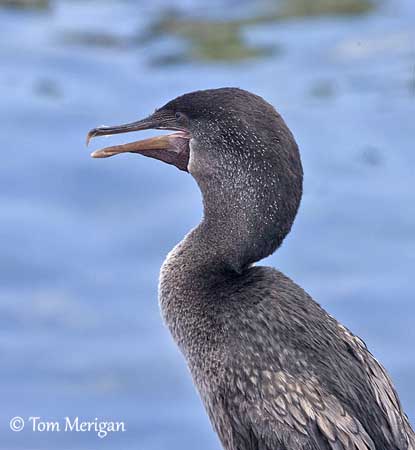
BEHAVIOUR:
The Flightless Cormorant feeds on aquatic preys such as fish, octopus and squid. As other cormorants, it feeds by pursuing its prey underwater.
As this species does not fly, legs and feet are stronger and larger than in other Phalacrocoracidae.
The loss of flight could be closely related to the absence, formerly, of terrestrial predators in Galapagos Islands. The Flightless Cormorant has very reduced wings, almost similar to penguin flippers. This peculiar feature comes from its ancestors. When they have arrived on these islands, the predatory mammals were absent. They did not need to fly and these populations were isolated.
The evolution related to these factors made them flightless, but in compensation, they developed stronger webbed feet. They can swim with powerful propulsion, as well on the surface as for diving and pursuing the preys underwater.
As other cormorants, it typically stands with outstretched wings to dry them after fishing.
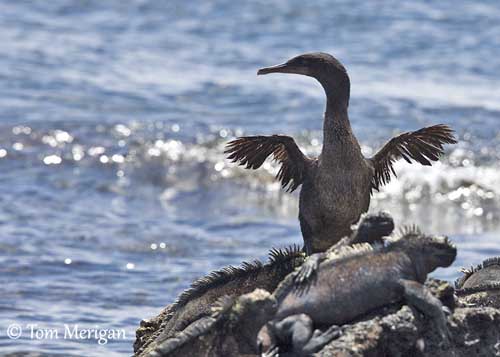
With two
Marine Iguanas
During the breeding season, the Flightless Cormorant performs ritual displays which start in the water and continue on the shore.
In the water, both mates circle one another in spiral-shape, while adopting a snake-like posture with bent neck. Then, they rise up in the water while fluttering their wings. They reach the shore where the male still adopts the same snake-like posture in front of the female. They also perform a “cormorant version” of the “penguin-walking”, by walking together side to side with bent neck and bill pointed downwards.
They build the nest together, and the male brings continually nest-materials which are arranged by the female. These “gifts” may include aquatic plants, but also rope, plastic and other debris found at sea.
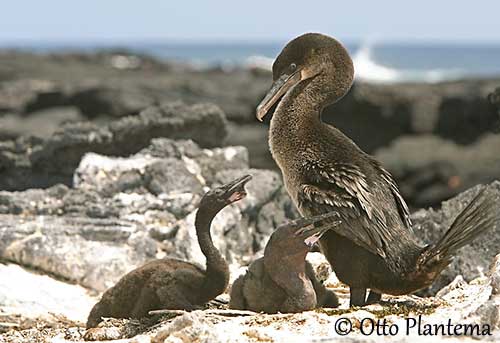
The Flightless Cormorant is sedentary, limited by its peculiar morphology. It is strongly attached to its breeding grounds, and even for feeding, remains within one kilometre away.
FLIGHT:
The Flightless Cormorant is not able to fly due to its reduced wings.
REPRODUCTION:
The Flightless Cormorant may lay all year round, but mainly between March and September. It may produce two clutches.
It breeds in small groups of 10-12 pairs along the rocky shores, building the nest just above the high tide limit. This is a bulky structure made with seaweeds, sea urchins, starfish and dead fish. Various types of debris can be added, brought by the male as “gifts” to the female.
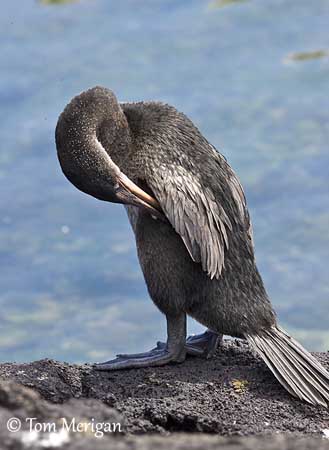
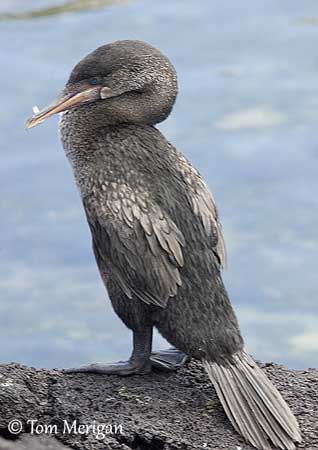
She lays 2-3 white eggs. Both parents share the incubation during 35 days. They often exchange coarse grunts as they take turns and the bird coming back to the nest offers some seaweeds to it/her mate to strengthen the pair-bonds.
At hatching, the chicks are naked, but a blackish down grows very soon. They fledge two months later, but they still depend on parents for about four months more. The male often feed them at the end of the cycle, while the female initiates a new breeding attempt.
Usually, two eggs hatch, but only one chick fledges. It reaches the sexual maturity in the second year.
The pair-bonds last only for one clutch, sometimes two.
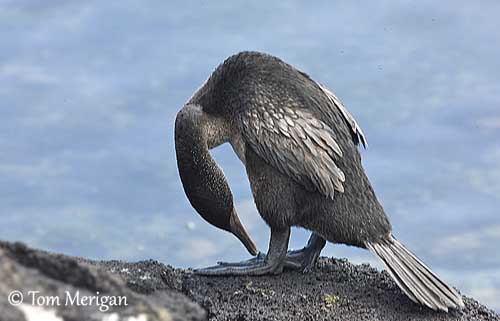
DIET:
The Flightless Cormorant feeds mainly on fish such as eels and rockfish. It also takes octopus and squid near the bottom.
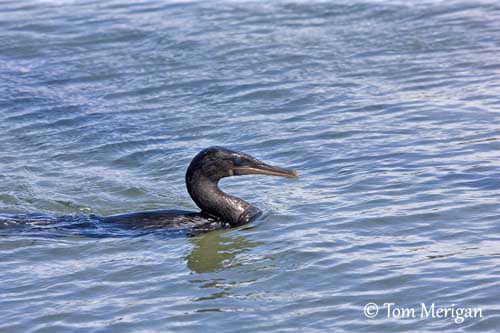
PROTECTION / THREATS / STATUS:
The Flightless Cormorant has very restricted range and is threatened by introduced mammal predators such as feral dogs. Decline often occurs due to lack of marine preys, but the species is able to recover rapidly. They also may be trapped in nest used for catching crustaceans and large fish.
Natural disasters such as El Niño also involve high mortality, but populations can recover in about 18 months.
